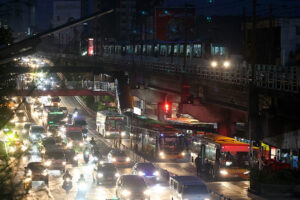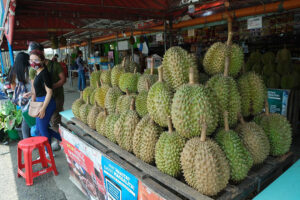Economic prospects, EDSA and holiday economics

(Part 2)
It is not going to be a walk in the park, that goal of the Philippine government to achieve between 6.5%-7.5% growth this year in order to generate economic opportunities, create more jobs, raise per capita incomes and elevate the Philippine economy to upper middle income country status by 2025. The output target next year is even more ambitious at 6.5%-8% until the end of the Marcos Jr. presidency. But being ambitious is actually vital if we are to address the economic scarring of the recent health pandemic, regain our previous growth path, and make some headway against poverty, income inequality, and environmental risks.
But how does one navigate this difficult course when, one, public policy choices continue to need better thinking and timing; two, when macroeconomic fundamentals might even weaken before they firm up; and, three, when civil society is going the way of division rather than unity?
For agricultural policy alone, true, new Agriculture Secretary Francisco Tiu Laurel, Jr. was correct in prioritizing food production and agricultural modernization. These are crucial to achieving food security and less import dependence for basic food requirements. If food production receives utmost attention, this could help lift millions of farmers and fisherfolk out of poverty. Secretary Laurel was spot on in his plan to make farming more profitable and attractive to entrepreneurship.
The urgency is to diversify food production, invest in and provide infrastructure for drying and warehousing crops, establishing good access to markets through decent road networks. Massive agricultural efficiency can be achieved by harnessing technology to improve rice production and reduce post-harvest losses. No doubt, a process is involved and it takes time for the various policy components to gel and produce results.
But what is the emerging scenario?
On Feb. 23, the broadsheets reported that the country’s imports had reached almost 570 thousand metric tons (tmt) this year, already over 44% more than the first two months imports of 395 tmt in 2023. Initial estimates put the whole-year rice imports at some 3.9 million metric tons (mmt) compared to last year’s 3.6 mmt. One way to interpret this development is that this is in preparation for El Niño’s challenge to domestic rice production. A plus for risk management.
But three days ago, on March 5, the Ombudsman suspended the chief of the National Food Authority (NFA) and 138 other employees due to the anomalous sale of the government’s rice buffer stock, something that is required to forestall any shortage of rice during the lean season. We seem to be importing, with the one hand, much more during this dry spell to manage our rice inventory; but selling down our rice buffer stock with the other hand.
There is an incentive in over importing by the rice agency.
Excess stock could be sold off as “spoiled rice” at a bargain only to be recycled, not as animal feed, but as re-polished rice and sold at premium retail prices. Secretary Laurel should take a deep dive into the NFA issue because its importation level is normally determined by the Council upon the recommendation of the staff and the advice of the Department of Agriculture. Somebody is into economic sabotage.
It would be impossible for the government to convince people that “the Philippines has ample rice supply.” Yes, even when, one, some 600 tmt arrived in the first two months of 2024 to supplement domestic production of 20.1 mmt; two, the damage of El Niño, so far, has been claimed to be comparatively mild at P357 million; and, three, the Agricultural Credit Policy Council is prepared to assist farmers up to P500 million for fuel assistance, rice seeds, and the distribution of shallow tube wells and solar-powered irrigation systems.
If there is enough rice supply, we should not be seeing the red flag signifying some inflationary build-up, from 2.8% in January to 3.4% in February, which was mostly caused by higher rice prices. As National Statistician Claire Dennis Mapa explained: “Rice inflation… contributed 1.6 percentage points of the 3.4% headline inflation… that’s about 47%.” Nearly half of the nation’s headline inflation came from rice.
Other public policies promise doom rather than boom in the economy.
A classic example is the two houses of Congress which are outbidding each other for the size of the adjustment in legislated wages, ranging from P100 to P350 per worker, per day. Our elected legislators are playing with fire by promising the labor sector that the adjustment is across the board instead of doing it by region. And unless the wage hikes are supported by productivity gains and capacity of employers to pay, this is suicide for the economy because unemployment will ensue, and inflation will surge again. We all agree labor deserves some wage increase in view of their diminished purchasing power. But there is space for Congress to be more circumspect.
Two, on macroeconomic fundamentals, there are unmistakable wild cards that could frustrate growth and price stability. No matter how one looks at it, the impact of El Niño could not be mild. No less than the national weather service, PAGASA, has admitted that as early as January, the Philippines has started to experience strong and mature El Niño. This means we could, with high probability, enter a season with temperatures reaching from 36.5 to 40 degrees Celsius in Metro Manila and at least in Northern Luzon.
Growth-wise, agriculture, which accounts for some 9% of our GDP, would suffer from a prolonged, debilitating dry spell that has already affected at least 17 provinces with dry conditions, 10 provinces with dry spells, and 14 with actual drought. When El Niño reaches its peak sometime in April or May, some 80 provinces and 275,000 hectares of farms will be hit, with some 41 experiencing actual drought conditions.
Price-wise, the Bangko Sentral ng Pilipinas’ risk-adjusted inflation forecasts of 3.9% in 2024 and 3.5% in 2025 could hold sway rather than its lower baseline forecasts. They are uncomfortably near the edge. Food products, particularly rice, corn, and meat products, are vulnerable to extreme heat conditions. Most important, with rice prices acting up again, we might be going into what the Bank for International Settlements (2022) described as “rational inattention.”
The broadening price pressures could cause households and firms to move out of this zone within which inflation may not have much influence on their behavior. Instead, they could be more attentive to just a few price developments like those of rice and other key food commodities. Demand for higher wages and price adjustments could be unjustifiably large if only based on the prices of these few items.
With this, any news on the possible rebound of the stock market, from just over 6,000 to 7,500-8,300, could be at best a pipe dream because we have a central monetary authority that does not operate on impulse.
In the same breath, what could worry investors is the sustained accumulation of National Government (NG) debt and its impact on growth and interest rates. As of January this year, NG debt stood at P14.8 trillion. This means the NG has chosen to borrow in a bigger way to finance the budget deficit. This is unavoidable because, one, a marching order has been issued by the Department of Budget and Management to ramp up public spending and, two, additional flagship infra projects have been lined up by this government to the tune of more than P9 trillion. With possible crowding out in the capital markets, market interest rates could remain elevated. Looking ahead, higher debt servicing requirements could also squeeze economic growth.
Finally, we end this piece where we began, and this is the issue of ensuring strong public ownership of government policies and initiatives. There are both economics and politics involved here. The economics is easier to address; all it takes is to show that specific public policies — whether agricultural, fiscal, or monetary — have good public goods content, that such initiatives serve the broader community, and protect them from further economic disenfranchisement courtesy of inflation and joblessness, then the likelihood of public support is higher.
The politics is more problematic.
When those elected or appointed to public office betray their propensity for bad governance, rallying public support will require more than a nudge. Richard Thaler and Cass Sunstein’s so-called choice architects will have some difficulty guiding public opinion unless they resort to fake news and troll farms. The decision of the Palace to choose silence in the celebration of the 1986 EDSA People’s Revolt serves to trivialize, belittle in fact, the people’s shared vision to fight for democracy and freedom. The move to change the Philippine Charter should not be cast in the spirit of repudiating the spirit of EDSA. EDSA never failed us, we failed EDSA.
To delete the EDSA celebration on Feb. 25 from the list of public holidays in the name of “holiday economics” could fan public outcry and remind the people again why it is celebrated every year. That could not only be interpreted as “another attempt to revise history,” it could also be divisive and explosive.
That is bad for the economy.
Diwa C. Guinigundo is the former deputy governor for the Monetary and Economics Sector, the Bangko Sentral ng Pilipinas (BSP). He served the BSP for 41 years. In 2001-2003, he was alternate executive director at the International Monetary Fund in Washington, DC. He is the senior pastor of the Fullness of Christ International Ministries in Mandaluyong.




